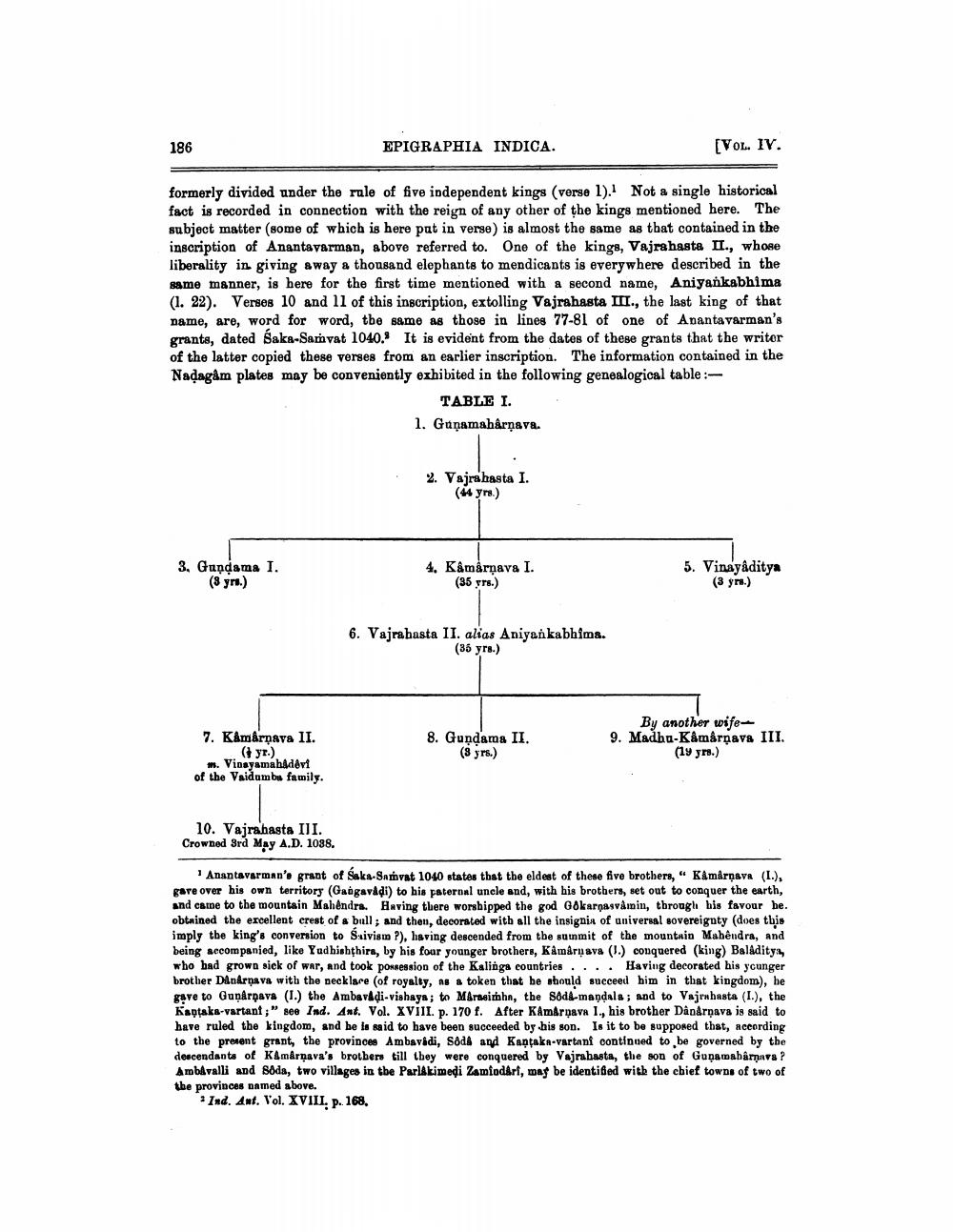________________
186
EPIGRAPHIA INDICA.
[VOL. IV.
formerly divided under the rule of five independent kings (verse 1). Not a single historical fact is recorded in connection with the reign of any other of the kings mentioned here. The subject matter (some of which is here pat in verse) is almost the same as that contained in the inscription of Anantavarman, above referred to. One of the kings, Vajra hasta II., whose liberality in giving away a thousand elephants to mendicants is everywhere described in the same manner, is here for the first time mentioned with a second name, Aniyankabhima (1. 22). Verses 10 and 11 of this inscription, extolling Vajrahasta III., the last king of that name, are, word for word, the same as those in lines 77-81 of one of Anantavarman's grants, dated Saka-Samvat 1040. It is evident from the dates of these grants that the writer of the latter copied these verses from an earlier inscription. The information contained in the Nadagam plates may be conveniently exhibited in the following genealogical table :
TABLE I. 1. Gunamahârnava.
2. Vajra hasta I.
(44 yrs.)
3. Gundama I.
(8 yrs.)
4. Kåmårņava I.
(35 yrs.)
5. Vinayaditya
(3 yrs.)
6. Vajrahusta II. alias Aniyankabhima.
(35 yrs.)
7. Kámárņava II.
(t yr.) m. Vinayamahadevi of the Vaidumba family.
8. Gundama II.
(8 yrs.)
By another wife 9. Madhu-Kåmårnava III.
(19 yrs.)
10. Vajrabasta IJI. Crowned 3rd May A.D. 1038.
Anantavarman's grant of Saka-Samvat 1040 states that the eldest of these five brothers, " Kamarnava (1.), gare over his own territory (Gangavadi) to his paternal uncle and, with his brothers, set out to conquer the earth, and came to the mountain Mahendra. Having there worshipped the god Gokarnasvamin, through his favour be. obtained the excellent crest of & bull; and then, decorated with all the insignia of universal sovereignty (does this imply the king's conversion to Suivism P), having descended from the summit of the mountain Mahendra, and being accompanied, like Yudhishthira, by his four younger brothers, Kamaruava (1.) conquered (king) Baladity, who had grown sick of war, and took possession of the Kalinga countries .... Having decorated his younger brother Dinarnava with the necklace (of royalty, as a token that be should succeed him in that kingdom), he gave to Gupârnava (1.) the Ambavadi-vishaya; to Márasimhn, the sodd-mandals; and to Vajrahasta (I.), the Kaptaks-vartant;" see Ind. Ant. Vol. XVIII. p. 170 f. After KAmarnava 1., his brother Danarnava is said to have ruled the kingdom, and he is said to have been succeeded by his son. Is it to be supposed that, according to the present grant, the provinces Ambavidi, Sod& and Kantaka-vartant continued to be governed by the descendants of Kimarnava's brothers till they were conquered by Vajrabasta, the son of Guņamabârnava ? AmbAvalli and Søda, two villages in the Parlakimedi Zamiodari, may be identified with the chief towns of two of the provinces named above.
* Ind. Ant. Vol. XVIII. p.168.




